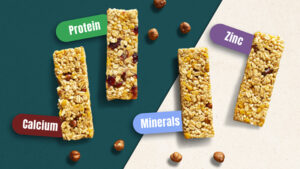Battling Malnutrition, Childhood Obesity, and Picky Eating Habits
Adequate nutrition in early life is very important for children’s health and human adult’s wellbeing. Malnutrition is increasing day by day in underdeveloped as well-developed countries due to poor feeding practices and poor dietary habits (Kupka et al. 2020). Diets with low concentrations of nutrients such as protein and minerals contribute to the increase of diseases (Müller & Krawinkel, 2005; World Health Organization, 2014), besides affecting the growth and development of children (United Nations Children’s Fund, 2018).
Childhood obesity has become a serious public health problem in recent decades and is associated with severe health disorders and risk of illness (de Onis et al., 2010). Already in 1997, the World Health Organization (WHO) has announced obesity as one of the most severe hazards to the health of children and adults [WHO Report, 1997]. The only two modifiable elements of the energy balance are food intake and activity-related energy expenditure (Dietz&Gortmaker,2001).
Children have long been recognized as discerning eaters. Their food choices are generally guided by their preferences that establish already early in life. In real-life settings, a multitude of factors come into play, influencing food choices. These include product packaging, social settings, and individual appetites.
Even though marketing interest in child consumers has been increasing lately with increasing number of advertisements (Šramová, 2015), children still pose a significant challenge for parents trying to introduce them to more nutritious food options. The products that appear “too healthy” can meet with their resistance. This aversion is exacerbated when children fear embarrassment, especially when eating such foods in front of friends (Holmer et al., 2012) .
Even with knowledge about healthier food options, children tend to gravitate toward what they find palatable and familiar.
Snacking Revolution: Shifting from Unhealthy to Nutritious Choices for Children
In recent years, the snacks market has expanded from the conventional unhealthy products (e.g., chocolates, biscuits, and chips) toward healthy snacks such as fruits, dairy products and different types of snack bars.
Considering nutritional demands of children and development of appropriate eating habits, children need to be provided “snacks” that apart from taste values would also be sources of: high-quality protein, dietary fiber, easily digestible fat and other valuable components.
According to the State of Snacking Global Trend Study 2022, 71% of consumers worldwide reported to snack at least twice a day. Despite current increasing food prices, consumers – especially millennials – acknowledge to always have room in their budget for snacks (Mondelez International et al., 2023). Not only adults are increasingly snacking, toddlers and children have been shown to frequently snack too (Dunford & Popkin, 2018; Ziegler et al., 2006). Furthermore, childhood snacking is moving toward three snacks per day, covering more than a quarter of children’s daily calories (Piernas & Popkin, 2010)
Snack bars are considered ready-to-eat food and are increasingly present in the diet of children. Adults and children eat bars at similar frequencies: on average, 11 times per month, with about one in four eating them daily (Cargill, 2021). These foods attract the consumers due to their versatility and convenience (Ramírez-Jiménez et al., 2018), besides the high sensorial quality. Whole grains, fruits, nuts and berries are recommended as a part of a healthy dietary intake because of their high nutritional value and health benefits such as reduced risk of coronary heart diseases (14, 15).
Snack bars most often serve as a between meal snack for both parents and kids, but more often serve as a dessert for kids after a meal (Cargill, 2021). Top attributes for kids’ bars include: natural (20%), made with organic ingredients (14%), high in protein (12%), high in fiber (8%).
The Triad of Children Snack bars Acceptance: Appearance, Taste, and Familiarity
A study done by Holmer et al. (2012) revealed interesting findings regarding children snack bar acceptance. A total of 134 Danish (68 girls and 66 boys) and 109 Swedish (63 girls and 46 boys) children aged 8 – 11, participated in the study. Five Nordic snack bars varying in the composition of Nordic ingredients were produced for the study. Testing was done in classrooms during morning lessons.
The kamut/pumpkin and oat/cranberry bars were given the highest liking scores in both countries. The bars given the lowest liking scores in both countries were pumpernickel/sea buckthorn and buckwheat/strawberry. Ratings did not differ significantly between genders. Further, the buckwheat/strawberry bar was one of the least liked bars although the ratings for appearance and smell corresponded to the bars that were liked. The result indicates the importance of considering all of the sensory modalities in order to design acceptable food products for children.
The sensory testing showed that children’s acceptance and preferences for the snack bars varied according to the composition of sensory properties.
This finding indicates that foods rated high in appearance may appeal more to children and thereby promote tasting in particular in children with high food neophobia; however, the actual flavour is the most important determinant of children’s liking. Flavor, texture, odor, and appearance significantly impact the overall liking of the bars among children. Flavor, in particular, is the single most crucial factor, underscoring the notion that taste plays. Colourful and golden snack bars are more appealing to children in terms of appearance when compared to darker-colored alternatives. This suggests that visual appeal is a critical factor in influencing children’s snack choices. Familiarity plays important role for children’s acceptance. snack bars that were described as “popcorn-like” or reminiscent of breakfast cereals emerged as the more liked and preferred options.
Children’s preferences for initially disliked foods tend to improve with more opportunities to try them. Sometimes, it can take ten or more exposures for a child to start liking a previously disliked food. A study done by Hausner et al. (2012) showed the majority of children exposed to an initially disliked snack bar increase acceptance after nine exposures to the same level as an initially liked bar.
Conclusion
By paying attention to their sensory preferences, appearance, and taste, parents, educators, and researchers can collaborate to make nutritious options more enticing to even the most selective young palates. With a blend of science and creativity, we can nurture healthier snacking habits in our children, paving the way for a lifetime of improved well-being and health. By encouraging children to embrace whole grains from an early age, we lay the groundwork for healthier and more prosperous lives. Hence, the development of healthier snacks high in beneficial nutrients is imperative to foster healthier diets. Recognizing food factors that influence food choices among kids and working with these elements can make healthier options more appealing to children.
References:
Kupka, R., Siekmans, K., & Beal, T. (2020). The diets of children: Overview of available data for children and adolescents. Global Food Security, 27, 100442. doi:https://doi.org/10.1016/j.gfs.2020.100442
Müller, O. and Krawinkel, M. (2005) Malnutrition and Health in Developing Countries. Canadian Medical Association Journal, 173, 279-286.
http://dx.doi.org/10.1503/cmaj.050342
Šramová, B. (2015). Marketing And Media.Communications Targeted to Children as Consumers. Procedia – Social and Behavioural Sciences, 191, 1522-1527
Holmer A, Hausner H, Reinbach HC, Bredie WL, Wendin K. , 2012 Acceptance of Nordic snack bars in children aged 8-11 years. Food Nutr Res.;56. doi: 10.3402/fnr.v56i0.10484. Epub 2012 Apr 24. PMID: 22545034; PMCID: PMC3337749.
Dunford EK, Popkin BM. 37 year snacking trends for US children 1977-2014. Pediatr Obes. 2018 Apr;13(4):247-255. doi: 10.1111/ijpo.12220. Epub 2017 May 15. PMID: 28508580; PMCID: PMC5685944.
Piernas C, Popkin BM. Snacking increased among U.S. adults between 1977 and 2006. J Nutr. 2010 Feb;140(2):325-32. doi: 10.3945/jn.109.112763. Epub 2009 Dec 2. PMID: 19955403; PMCID: PMC2806886.
Cargill, 2021. Breaking the boundaries in new bar development.
Hausner H, Hartvig DL, Reinbach HC, Wendin K, Bredie WL. Effects of repeated exposure on acceptance of initially disliked and liked Nordic snack bars in 9-11 year-old children. Clin Nutr. 2012 Feb;31(1):137-43. doi: 10.1016/j.clnu.2011.08.003. Epub 2011 Aug 24. PMID: 21868139.





